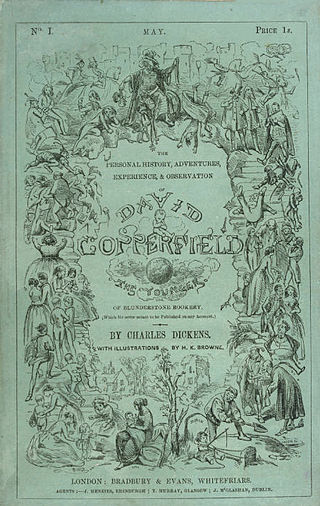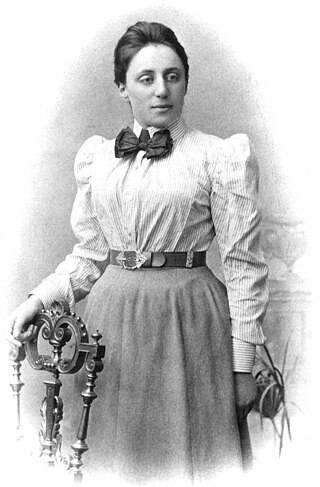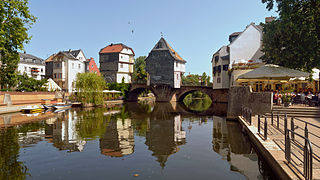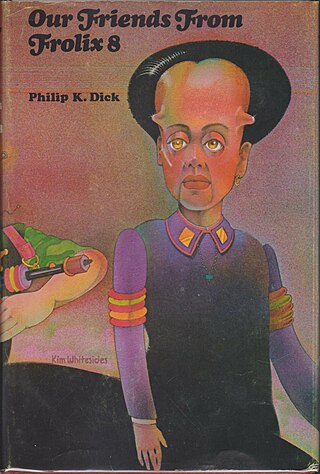
Karlheinz Stockhausen was a German composer, widely acknowledged by critics as one of the most important but also controversial composers of the 20th and early 21st centuries. He is known for his groundbreaking work in electronic music, having been called the "father of electronic music", for introducing controlled chance into serial composition, and for musical spatialization.

Mars, the fourth planet from the Sun, has appeared as a setting in works of fiction since at least the mid-1600s. Trends in the planet's portrayal have largely been influenced by advances in planetary science. It became the most popular celestial object in fiction in the late 1800s, when it became clear that there was no life on the Moon. The predominant genre depicting Mars at the time was utopian fiction. Around the same time, the mistaken belief that there are canals on Mars emerged and made its way into fiction, popularized by Percival Lowell's speculations of an ancient civilization having constructed them. The War of the Worlds, H. G. Wells's novel about an alien invasion of Earth by sinister Martians, was published in 1897 and went on to have a major influence on the science fiction genre.

The history of Norfolk Island dates back to the fourteenth or fifteenth century when it was settled by Polynesian seafarers.

Philip Kindred Dick, often referred to by his initials PKD, was an American science fiction writer and novelist. He wrote 44 novels and about 121 short stories, most of which appeared in science fiction magazines during his lifetime. His fiction explored varied philosophical and social questions such as the nature of reality, perception, human nature, and identity, and commonly featured characters struggling against elements such as alternate realities, illusory environments, monopolistic corporations, drug abuse, authoritarian governments, and altered states of consciousness. He is considered one of the most important figures in 20th century science fiction.

David Copperfield is a novel by Charles Dickens, narrated by the eponymous David Copperfield, detailing his adventures in his journey from infancy to maturity. As such, it is typically categorized in the bildungsroman genre. It was published as a serial in 1849 and 1850 and then as a book in 1850.

Amalie Emmy Noether was a German mathematician who made many important contributions to abstract algebra. She proved Noether's first and second theorems, which are fundamental in mathematical physics. She was described by Pavel Alexandrov, Albert Einstein, Jean Dieudonné, Hermann Weyl and Norbert Wiener as the most important woman in the history of mathematics. As one of the leading mathematicians of her time, she developed theories of rings, fields, and algebras. In physics, Noether's theorem explains the connection between symmetry and conservation laws.

I. G. Farbenindustrie AG, commonly known as IG Farben, was a German chemical and pharmaceutical conglomerate. It was formed in 1925 from a merger of six chemical companies: Agfa, BASF, Bayer, Chemische Fabrik Griesheim-Elektron, Hoechst, and Weiler-ter-Meer. It was seized by the Allies after World War II and split into its constituent companies; parts in East Germany were nationalized.

Alfred Willi Rudolf "Rudi" Dutschke was a German sociologist and political activist who, until severely injured by an assassin in 1968, was a leading charismatic figure within the Socialist Students Union (SDS) in West Germany, and that country's broader "extra-parliamentary opposition" (APO).

Bad Kreuznach is a town in the Bad Kreuznach district in Rhineland-Palatinate, Germany. It is a spa town, most well known for its medieval bridge dating from around 1300, the Alte Nahebrücke, which is one of the few remaining bridges in the world with buildings on it.
Operation Gladio was the codename for clandestine "stay-behind" operations of armed resistance that were organized by the Western Union (WU), and subsequently by NATO and by the CIA, in collaboration with several European intelligence agencies during the Cold War. Although Gladio specifically refers to the Italian branch of the NATO stay-behind organizations, Operation Gladio is used as an informal name for all of them. Stay-behind operations were prepared in many NATO member countries, and in some neutral countries.

Ailanthus altissimaay-LAN-thəss al-TIH-sim-ə, commonly known as tree of heaven, Ailanthus, varnish tree, copal tree, stinking sumac, Chinese sumac, paradise tree, or in Chinese as chouchun, is a deciduous tree in the family Simaroubaceae. It is native to northeast and central China, and Taiwan. Unlike other members of the genus Ailanthus, it is found in temperate climates rather than the tropics.

Our Friends from Frolix 8 is a 1970 science fiction novel by American writer Philip K. Dick. The novel is set in the 22nd century, where humanity is ruled by mutated humans, "New Men" and "Unusuals", while normal "Old Men" are discriminated against. The story follows Nick Appleton, a low-class worker who falls in love with a subversive agent, while Thors Provoni has gone deep into space to find an ally to the resistance.
Literature of the 20th century refers to world literature produced during the 20th century.
"Novelty Act" is a short story by Philip K. Dick. It involves a dystopian future in which the characters' lives are based on entertaining the First Lady of the United States with "novelty acts." Many of the ideas developed in the story were reworked and reused for his later novel The Simulacra.

A simulacrum is a representation or imitation of a person or thing. The word was first recorded in the English language in the late 16th century, used to describe a representation, such as a statue or a painting, especially of a god. By the late 19th century, it had gathered a secondary association of inferiority: an image without the substance or qualities of the original. Literary critic Fredric Jameson offers photorealism as an example of artistic simulacrum, in which a painting is created by copying a photograph that is itself a copy of the real thing. Other art forms that play with simulacra include trompe-l'œil, pop art, Italian neorealism, and French New Wave.

A novel is an extended work of narrative fiction usually written in prose and published as a book. The English word to describe such a work derives from the Italian: novella for "new", "news", or "short story ", itself from the Latin: novella, a singular noun use of the neuter plural of novellus, diminutive of novus, meaning "new". According to Margaret Doody, the novel has "a continuous and comprehensive history of about two thousand years", with its origins in the Ancient Greek and Roman novel, Medieval Chivalric romance, and in the tradition of the Italian Renaissance novella. The ancient romance form was revived by Romanticism, in the historical romances of Walter Scott and the Gothic novel. Some novelists, including Nathaniel Hawthorne, Herman Melville, Ann Radcliffe, and John Cowper Powys, preferred the term "romance". M. H. Abrams and Walter Scott have argued that a novel is a fiction narrative that displays a realistic depiction of the state of a society, while the romance encompasses any fictitious narrative that emphasizes marvellous or uncommon incidents. Works of fiction that include marvellous or uncommon incidents are also novels, including Mary Shelley's Frankenstein, J. R. R. Tolkien's The Lord of the Rings, and Harper Lee's To Kill a Mockingbird. Such "romances" should not be confused with the genre fiction romance novel, which focuses on romantic love.

Native Americans in German popular culture have, since the 18th century, been a topic of fascination, with imaginary Native Americans influencing German ideas and attitudes towards environmentalism, literature, art, historical reenactment, and German theatrical and film depictions of Indigenous Americans. Hartmut Lutz coined the term Indianthusiasm for this phenomenon.














